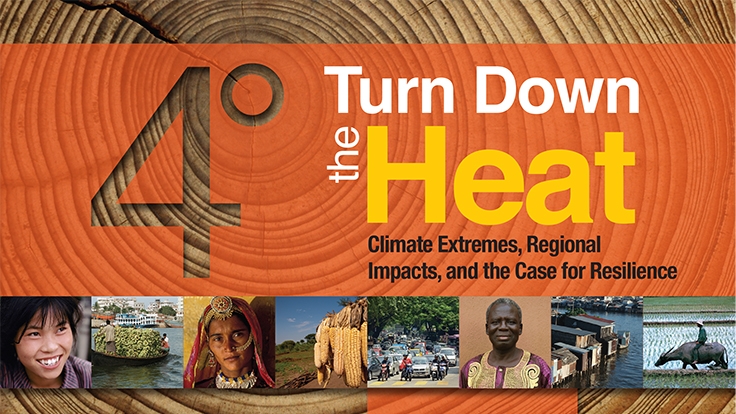19 June, 2013: Late last year, the World Bank released a report – Turn Down the Heat – which concluded the world would warm by 4°C by the end of this century if concerted action was not taken now. A new report, released today, spells out an alarming scenario that could unfold as a result of global warming.
The new report - Turn Down The Heat: Climate Extremes, Regional Impacts and the Case for Resilience – looks at the likely impact of warming on agricultural production, water resources, coastal ecosystems and cities across three regions - South Asia, Sub-Saharan Africa, and South East Asia. It assesses impacts at present day temperatures of 0.8°C above pre-industrial levels, as well as in a world that is warmer by 2°C and 4°C.
The report finds that if the world warms by 2°C - which may happen within the next 20 to 30 years - widespread food and water shortages could unfold, together with prolonged droughts, unprecedented heat-waves, more intense rainfall and flooding, and a significant threat to energy production.
These are not challenges looming at the end of the century, the report says. Rather, severe impacts can begin to appear within the next 10-20 years, within the span of the current generation. Already, a warming trend has begun to emerge over South Asia, and India’s large and growing population is experiencing water stress in many parts.
Increasing temperatures, changing rainfall patterns, declining snowfall, retreating glaciers, and declining groundwater can make the situation even worse. Impacts can be aggravated by rising sea-levels and more intense tropical cyclones, precipitating a major crisis for food security and the rural economy.
Urban populations cannot escape the consequences of global warming, either. Densely populated urban areas, especially those with unplanned urbanization, would be increasingly at risk from prolonged spells of extreme heat, floods, and disease.
The case for resilience has never been stronger. Already, our world is 0.8°C above pre-industrial levels of the 18th century. Irrespective of future emission paths, the warming already underway will lead to a number of climate impacts. Many of the worst impacts could still be avoided by holding warming below 2°C, but the window for action is narrowing rapidly.
The onus is clearly on today’s generation to develop heat and drought resistant crops, improve ground water management, invest in water storage infrastructure, build adequate flood defenses, improve energy efficiency and the performance of renewable energies, ‘climate-proof’ critical public infrastructure that is locked in for long periods, and make cities more resilient to climate change. To minimize damage from floods and cyclones to human life and property, strong building codes will need to be enforced.
In a very real sense development is the best adaptation – investing in skills, health, knowledge, better infrastructure and a more diversified economy will render countries more climate-resilient.
The report therefore demands action - bold action - to ensure that the future of millions is not put at risk. This requires strong political will together with innovation, for early action on climate change will far outweigh the costs in the longer term.

